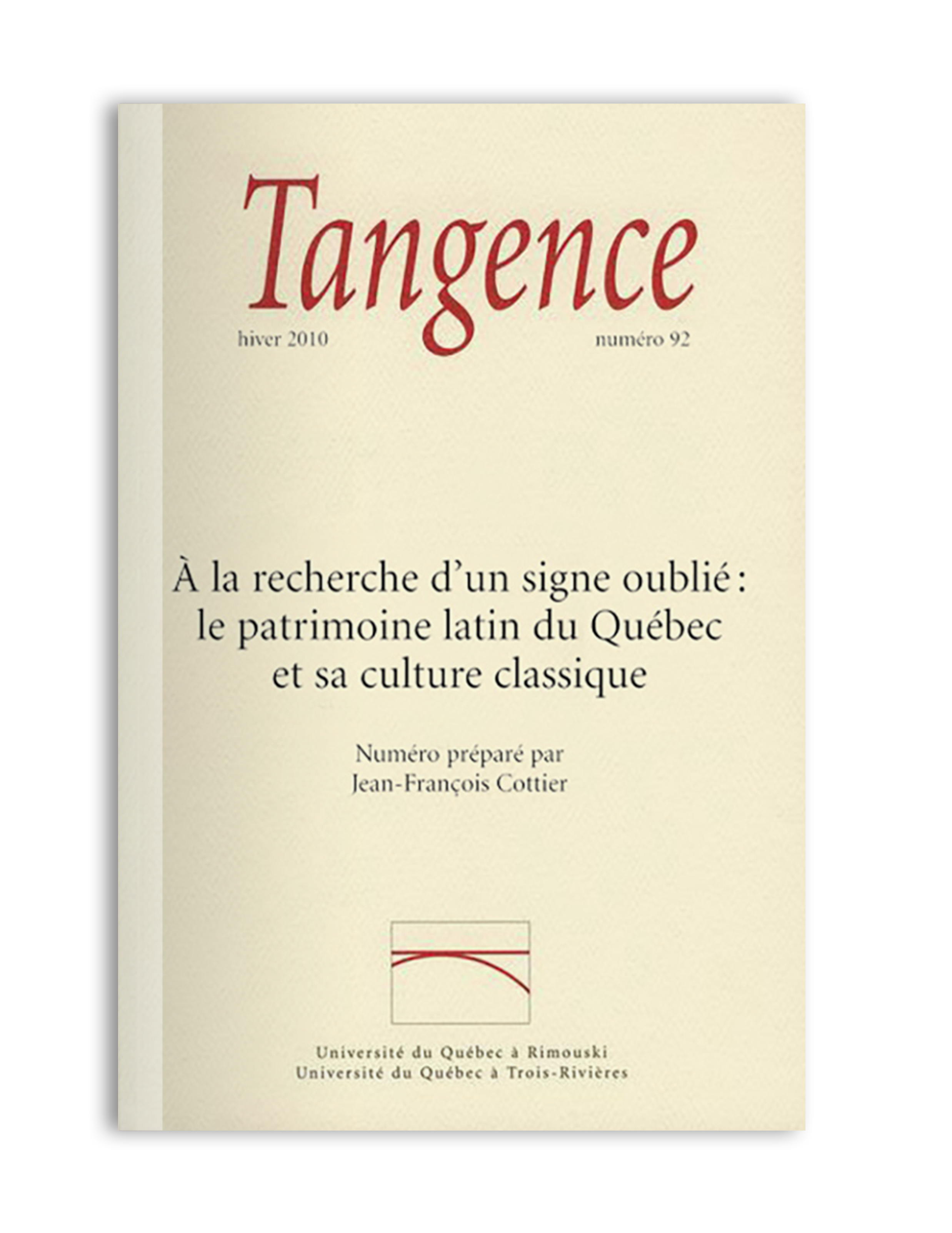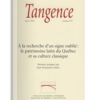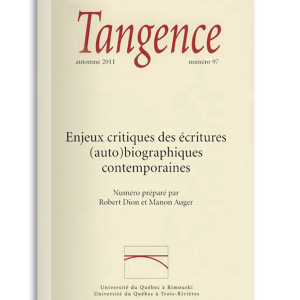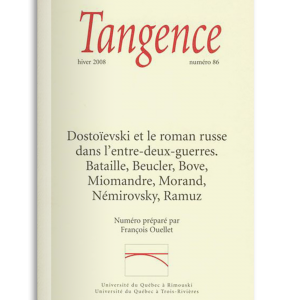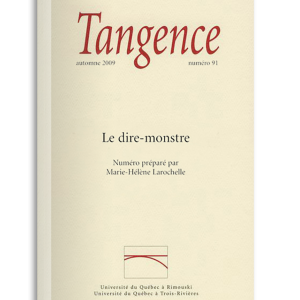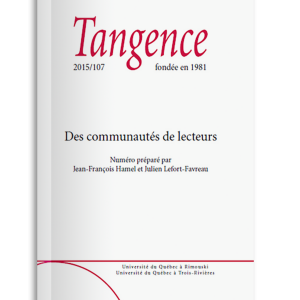N° 92, hiver 2010
À la recherche d’un signe oublié : le patrimoine latin du Québec et sa culture classique
Jean-François Cottier
Histoire du latin en Nouvelle-France (1608-1763) : premier état de la question
Le latin et sa tradition culturelle et pédagogique représentent un point aveugle de l’histoire littéraire et culturelle québécoise. Pourtant, les textes rédigés dans cette langue sont nombreux et offrent un témoignage littéraire et humain qu’on ne peut plus ignorer. Cet article tente d’établir un premier état de la question pour les écrits de la Nouvelle-France, en distinguant les textes spirituels et historiques, caractéristiques du XVIIe siècle, et ceux plus scientifiques, davantage représentatifs du XVIIIe siècle, tout en posant la question du choix de cette langue et de ce que celui-ci nous dit de la société qui les a produits.
Latin writings in New France (1608-1763) : first state of the issue
Latin and its cultural and pedagogical tradition represent a blind spot in the literary and cultural history of Québec. Nevertheless, many texts were written in that language and offer a literary and human testimony that can no longer be ignored. This article attempts to establish an initial state of the issue for the writings of New France by distinguishing the spiritual and historic texts characteristic of the seventeenth century from the scientific texts more representative of the eighteenth. At the same time, it poses the question of the choice of this language and what it tells us about the society that produced them.
***
Haijo Westra
Références classiques implicites et explicites dans les écrits des Jésuites sur la Nouvelle-France
Cet article s’intéresse à la pratique de la citation implicite des sources classiques dans les écrits latins des Jésuites sur le Canada, que l’on compare avec celle de la citation explicite, en usage chez les mêmes auteurs dans les Relations qui, elles, sont écrites en langue vernaculaire. L’analyse d’un poème latin figurant en tête du Journal des Jésuites permettra d’illustrer le propos, en montrant en quoi l’inspiration virgilienne dont il procède met en parallèle la situation désastreuse de la mission jésuite en Nouvelle-France vers 1650 avec celle des Troyens exilés dans l’Énéide de Virgile. Ce poème, dont la signification n’a pas été reconnue jusqu’à ce jour, témoigne d’une sensibilité se démarquant tout-à-fait de celle qui s’exprime dans les Relations.
Implicit and explicit classical references in the Jesuits’ writings on New France
This article focuses on the practice of implicit citation from classical sources in the Jesuits’ Latin writings about Canada, which is compared with the same authors’ practice of explicit citation in their Relations, written in the vernacular. The analysis of a Latin poem at the head of the Journal des Jésuites can serve as an example, since it demonstrates how the poem’s Virgilian inspiration places the disastrous situation of the Jesuit mission in New France circa 1650 in parallel with that of the Trojans in Virgil’s Aeneid. This poem, whose meaning has not been recognized to date, testifies to a sensibility that is quite different from that expressed in the Relations.
***
John E. Bishop
Qu’il y-a-t-il de si drôle dans la chasse au canard ? Ce que les ouvrages linguistiques nous disent de la rencontre entre les Jésuites et les Nehiraw-Iriniw
Cet article examine les différents registres linguistiques que l’on retrouve dans le corpus des écrits produits par les missionnaires jésuites au Canada durant les XVIIe et XVIIIe siècles. Ces manuscrits, qui regardent de très près l’activité quotidienne de la mission, ont été rédigés dans plusieurs langues amérindiennes et en latin. Ils permettent de mettre en évidence la qualité de l’attachement que manifestèrent les missionnaires envers la culture amérindienne et son environnement. Pourtant, ils ont été fréquemment délaissés par une historiographie où domine la référence aux Relations des jésuites. L’analyse du vocabulaire ornithologique permettra d’explorer la manière dont les Jésuites appréhendèrent la nature canadienne, tout en révélant une mutation dans la conception même de la mission dans le courant des XVIIe et XVIIIe siècles.
What’s so funny about the duck hunt ? What linguistic works tell us about the encounter between the Jesuits and the Nehiraw-Iriniw
This article examines the various linguistic registers in the corpus of writings produced by the Jesuit missionaries in Canada in the seventeenth and eighteenth centuries. These manuscripts, which focus narrowly on the daily activity of the mission, were written in several Amerindian languages and in Latin. They make it possible to underscore the quality of the missionaries’ attachment to the culture and environment of the Amerindians. The manuscripts have, however, often been neglected by a historiography dominated by reference to the Jesuits’ Relations. An analysis of ornithological vocabulary allows us to explore the Jesuits’ perception of nature in Canada, while revealing how the very conception of the mission mutated during the seventeenth and eighteenth centuries.
***
Amélie Hamel
Les Historiae Canadensis du père François Du Creux (Paris, 1664) : enjeux et problèmes littéraires
Cet article s’attache à la définition du statut des Historiae Canadensis (1664) du père François Du Creux, s.j., ouvrage rédigé en latin à partir de textes en langue vernaculaire. Le processus de « traduction-adaptation » opéré par l’auteur pose trois questions majeures relatives à sa poïétique. La première concerne la description des rapports entretenus par le texte avec ses sources, suivant deux types d’intervention possible. L’un touche le contenu et son organisation : la composition du substrat textuel (ou hypotexte) et l’agencement des éléments constitutifs de l’hypotexte dans l’œuvre. L’autre se rapporte aux interventions liées à la forme du texte. Cette première question, qui suppose une réflexion globale sur l’intertexte, conduit ensuite à envisager une seconde, portant sur le choix de la langue latine pour la rédaction des Historiae Canadensis et, enfin, une troisième, qui invite à s’intéresser au lectorat visé par la publication de ce texte à la fois historique et édifiant.
Father François Du Creux’s Historiae Canadensis (1664) : literary issues and problems
This article examines the definition of the status of Historiae Canadensis (1664) by Father François Du Creux, SJ, a work written in Latin based on texts in the vernacular. The « translation-adaptation » process performed by the author poses three key questions relative to his poetics. The first concerns a description of the text’s relations to its sources using two types of possible intervention. The first touches on the content and its organization : the composition of the textual substratum (or hypotext) and the arrangement of the constituent elements of the hypotext in the work. The other deals with interventions related to the shape of the text. This first question, which supposes a broad reflection on the intertext, then leads to consideration of a second, which deals with the choice of Latin for writing Historiae Canadensis and, finally, a third, which invites a look at the readership targeted by the publication of this text, at once historic and inspiring.
***
Irena Trujic
Jacques et Marie, souvenir d’un peuple dispersé : le modèle virgilien de Napoléon Bourassa
En analysant de quelle manière Napoléon Bourassa utilise l’Énéide de Virgile comme hypotexte de référence dans Jacques et Marie (1866), cet article met en évidence la fonction interprétative du patronage virgilien dans ce roman historique qui relate la Déportation des Acadiens au miroir du destin du peuple troyen, condamné lui aussi à être une gens sparsa. Si l’Énéide est le modèle clairement revendiqué par Bourassa, une lecture plus approfondie du texte montre, au surplus, que les Bucoliques jouent également un rôle dans le système référentiel du roman et donc dans sa signification.
Jacques et Marie, souvenir d’un people dispersé (Jacques and Marie, remembrance of a dispersed people) : Napoléon Bourassa’s Virgilian model
By analyzing how Napoléon Bourassa uses Virgil’s Aeneid as a hypotext of reference in Jacques et Marie(1866), this article highlights the interpretive function of Virgilian patronage in this historical novel, which recounts the deportation of the Acadians as a mirror of the fate of the Trojan people, likewise condemned to be a gens sparsa. If Bourassa clearly modelled his story on the Aeneid, a more in-depth reading of the text shows, moreover, that the Bucolics also plays a role in the referential system of the novel and, therefore, in its meaning.
***
Benoît Castelnérac
John Larkin et ses Eklekta mythistorias, un état du texte
Les Morceaux choisis d’histoires mythologiques (1837) de John Larkin, professeur de grec et de philosophie au Petit Séminaire de Montréal de 1827 à 1840, forment un recueil de mythes entièrement copié à partir de la Bibliothèque du pseudo-Apollodore (c. 100 apr. J.-C.) et destiné principalement à l’apprentissage du grec au niveau élémentaire. Cet article présente la manière dont Larkin a composé le texte à partir de sa source : ses altérations, ses omissions et la censure qu’il opère, ainsi que ses ajouts. On trouve, en annexe, un tableau comparatif complet entre les Morceaux choisis et les passages de la Bibliothèque.
John Larkin and his Eklekta mythistorias, a state of the text
The Morceaux choisis d’histoires mythologiques (Fragments of mythological tales) (1837) by John Larkin, a professor of Greek and philosophy at the Petit Séminaire de Montréal from 1827 to 1840, form a collection of myths copied entirely from the Library of the pseudo-Apollodorus (c. 100 A.D.) and intended mainly for teaching Greek at the primary level. This article examines the manner in which Larkin composed the text based on his source : his alterations, omissions, censorings and additions. A comprehensive comparison chart of the Morceaux choisis and passages from the Library is provided in the annex.

